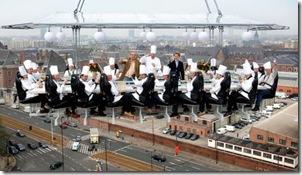Yesterday, I posted about blimps, and how magical I find the idea of floating around in one.
Today, well, there's a slightly different story.
My sister Trish sent me a link to an article in the Boston Globe, which talked about a local guy who's part owner of a Dinner in the Sky setup in the States. I'd read about this outfit before - the company is Belgian - but the concept's immigrated and now, you, too, can dine al fresco at 180 feet up on a 5 ton platform suspended from a crane. The platform accommodates 22 diners (hooked in with 4 point seat belts - just to make sure), and 3-5 staff members. (This photo apparently shows a sort of busman's holiday for chefs.
You rent the rig for 8 hours, and you're free spend the time on one really lllooonnnggg dinner, or a bunch of smaller events - a wine tasting, coffee, ice cream sundae party: you're in charge of the catering. (You can't expect this company to be good at both craning people up and food prep, can you? I'd rather have them be good at just one thing, and that's crane safety. Although, personally, I can't imagine wanting to be up there for a sip of water, let alone an 8 hour dinner but, as the Belgians no doubt say, chacun à son goût.
Dinner in the Sky's site is a trove of information.
First up on the FAQ's: what happens if you need to, errrrr, powder your nose.
Not to worry. You just raise your hand, as you once did in grammar school, and the crane lowers the boom for everyone. It only takes a minute - truly, not much longer than it would take to zoom to the facilities in a land-locked restaurant.
Worried about weather? You can take out cancellation insurance "which is 10% of your global budget + 15 % insurance fee." Whatever this means. (I think it loses something in the translation.)
And who wouldn't be thinking insurance, especially given a couple of recent crane collapses in NYC which were just plain old vanilla crane collapses that didn't involve 22 people, plus 3-5 chefs and wait-staff on a 5 ton platform? Dinner has "worldwide coverage," but they "advise [their] clients to take out an event insurance as an extra precaution." And, for us American litigious types: "Especially for our US customers we have an extra US$ 10 millions liability insurance policy in place which can be used for US$ 5.500/event day ." (You wouldn't want to lose your best customers, or key executives, without getting back a little walking around money.)
No open fires, by the way, but you can use a gas barbie. And if you're thinking of bringing the kiddies along. "Dinner in the sky is not age related but height related, we need to be able to secure you safely in your seat, minimum height is 150 cm."
I am truly wracking my brain here, but I can't think of one parent I know who'd be willing to head for the heights with a 150 cm tall kid strapped in - even if it is with a 4 point seat belt. Can you imagine what a relaxing meal that would be, worrying about whether little Johnny was going to get bored and decided he wanted to sit under the table and pound on his father's shoe for a while. But, wait, Johnny, there's no floor to crawl on...Johnny, JOHNNY. Oh, no. (That's why you just might need that extra $10 million in insurance.)
So far, in the US, the Dining in the Sky franchise is operating out of Las Vegas - but it's portable, sitting there on an 18 wheeler waiting to be trucked anywhere in the US. Prices are somewhat sky high - $35K for starters - and I'm guessing that doesn't include the fuel to haul it your way, let along all that extra insurance.
"Some people have compared it to eating on the top floor of a skyscraper with no walls and no floors," said [co-owner Michael][Gallant, 31, who lives in Revere [Massachusetts]. "The best way to describe it is dinner amongst the clouds."
Well, 180 feet isn't exactly amongst the clouds, unless it's a really foggy day. And then what a miserable dining experience that would be, what with no big roaring fire to take the chill off.
The apparatus was "built to German safety specifications that 'supersede some of the safety standards we have in the States.'"
Hmmm. Wasn't that what the makers of the Hindenberg said?
Anyway, Dinner in the Sky not likely to be coming my way anytime soon.
Boston public safety regulations for such offbeat operations are among the most stringent in the United States, according to Patricia Malone, the city's commissioner of consumer affairs and licensing. "There'd be extensive permitting and extensive public safety issues that the city would have to look into before we could determine whether or not Boston would be someplace [Dinner in the Sky] could do business," Malone said.
Thank you, Patricia Malone!
I'm sure that I would be having my first heart attack before that crane had hoisted my party even halfway off the ground.
Forbes has named Dinner in the Sky (which now operates in about 20 countries) one of the 10 "most unusual restaurants" in world. I'll have to get a hold of that list and check out what the other 9 might be.


